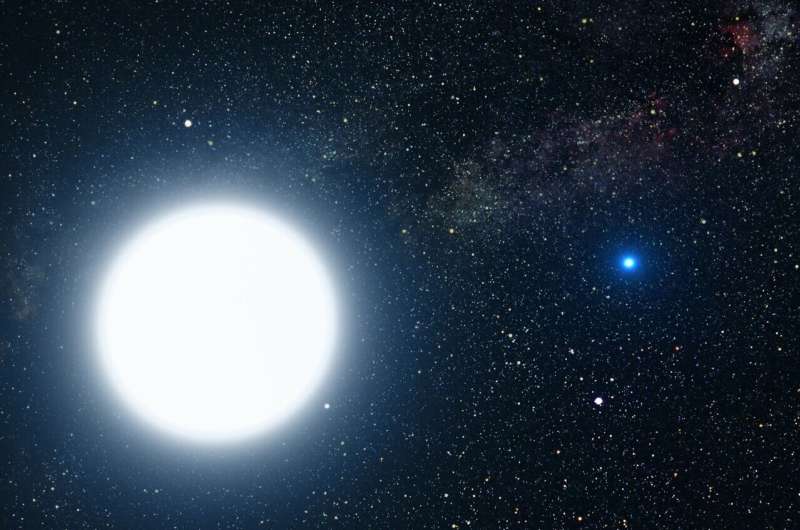This article has been reviewed according to Science X's editorial process and policies. Editors have highlighted the following attributes while ensuring the content's credibility:
fact-checked
trusted source
proofread
Watery planets orbiting dead stars may be good candidates for studying life—if they can survive long enough

The small footprint and dim light of white dwarfs, remnants of stars that have burned through their fuel, may make excellent backdrops for studying planets with enough water to harbor life.
The trick is spotting the shadow of a planet against a former star that has withered to a fraction of its size and finding that it's a planet that has kept its water oceans for billions of years even after riding out the star's explosive and violent final throes. A new study of the dynamics of white dwarf systems suggests that in theory, some watery planets may indeed thread the celestial needles necessary to await discovery and closer scrutiny.
Astronomers scrutinizing planets outside our solar system (called exoplanets) for potential signs of life gather data while those planets transit their star—or pass between the star and our telescopes. They use the light from the star that passes through the planets' thin layer of the atmosphere to tell them which elements and molecules are present.
A huge star roiling with full-powered nuclear fusion can be messy and difficult to look at. So, finding a planet orbiting a smaller and more mellow white dwarf makes for less of the astronomical equivalent of squinting.
"White dwarfs are so small and so featureless, that if a terrestrial planet transited in front of them, you could actually do a much better job of characterizing its atmosphere," says University of Wisconsin–Madison astronomy professor Juliette Becker, lead author of the study, which is under review at AAS Journals and was presented in Madison at the 244th meeting of the American Astronomical Society. "The planet's atmosphere would have a much larger, clearer signal because a larger fraction of the light you're seeing is passing through exactly what you want to study."
The first major hurdle for such a planet would be surviving the last days (relatively speaking) of a small- to medium-sized star. Because they can be rough.
When stars like our sun run out of the fuel driving their core's fusion reactions, they grow to enormous size.
"There are two pulses, basically, during which the star grows to 100 times its normal radius," Becker says. "While it does that—we can call this part Destruction Phase No. 1—it will engulf any planets that are within that radius."
Even if a water-harboring planet escapes being swallowed, it's not out of the flaming woods. The bulging growth of the star is followed by the loss of its mass and a huge spike in its brightness.
"The fact that the star gets so much brighter means that all planets in the system, even ones that used to be cold in the outer solar system, will suddenly have their surface temperatures increase drastically," Becker says. "That can evaporate their oceans and cost them a lot of water."
So, an Earth-like planet needs to sit at least roughly 5 to 6 astronomical units (1 AU being the average distance between Earth and our sun) away from its dying star to retain an appreciable amount of its water through the star swelling and the planet-eating and the light bombardment, according to the new study.
But the calm after the storm is another hurdle. Over the course of a billion or more years, the once-rampaging star will shrink and cool.
"If you can be sufficiently far away during this dangerous time that you don't lose your surface water, that's good," Becker says. "But the downside is you're going to be so far away from the star that all the water is going to be ice, and that's not great for life."
Eventually, the white dwarf will be so small and cold that a planet getting enough heat to have liquid water would have to be more like 1% of 1 astronomical unit away—very far in from the 5- to 6-AU safety line.
One way to shift a planet's orbit that much, called tidal migration, could help.
"A planet's orbit changing is pretty normal," Becker says. "In tidal migration, some dynamical instability between planets in the system puts one of them into a high-eccentricity orbit, like a comet, where it swings in really close to the central body in the system and then far out again."
Those kinds of orbits will settle into less-eccentric, more stable paths that could leave a planet very close to a white dwarf.
"If you put all these models together, what you see is that it is a perilous journey for the planet and difficult for oceans to survive this process, but it is possible," says Becker, whose collaborators include Andrew Vanderburg, a Massachusetts Institute of Technology astrophysicist who was recently a UW–Madison professor, and UW–Madison graduate student Joseph Livesey.
More work on the circumstances of potential white dwarf-planet pairings would help firm up the odds and guide decision-making when it's time to dole out limited telescope resources to search for planets that could support life.
"If we find a lot of white dwarfs that are good candidates to host potentially habitable exoplanets, they could be worth the time," says Becker. "And these theoretical techniques will help us separate the best targets, so we don't spend too much time on the uninteresting ones."
Provided by University of Wisconsin-Madison





















